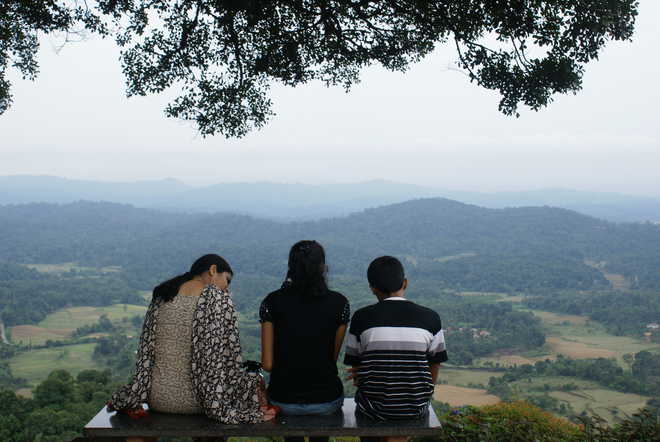In the hills of Coorg in Karnataka lies Madikeri, the town that gives a military feel & charms with its orderliness

Hugh and Colleen Gantzer
At first glance, Madikeri looks as precise and orderly as a cantonment. In a way, that’s what it is. According to a coffee-planter, “If you throw a stone in Madikeri, you’ll hit a General. If you throw two stones, you’ll probably get a brace of Colonels, bristly moustaches and all!” This could account for the military look of this cottage-dotted town in the hills of Coorg in Karnataka. Madikeri’s narrow, winding roads were meant for brisk walkers and horses. We felt this when we drove through the town to the Palace Fort.
It certainly is a Fort, with thick walls and deep gates. At the far end of its grounds, next to two enormous effigies of elephants is a board that proclaims:
“Mercara was founded by Prince Mudduraja of the Haleri dynasty in 1681 and named after him as Muddurajanakeri. This later became Madikeri by the locals. The British called it Mercara.”
At one corner is a steepled building, now a museum with hero-stones standing erect in the yard. We walked across this former Anglican Church. The light streaming in through its beautiful stained glass windows added to its meditative ambience, ideal for a museum. And, in a fitting tribute to India’s revered Field Marshal Cariappa, the former little vestry had been dedicated to the memory of this unforgettable army chief. He was a Coorgi, a Kodava.
From such shrines to the past, we drove down into town and parked at the gate of a living shrine: the impressive Sri Omkaresvara Temple.
Officially this is a Siva temple of the Lingayats but there are distinctly Islamic idioms in its eclectic architecture. It has a central dome with minarets at the four corners, surmounted by their own, smaller, domes. It is possible that the influence of Tipu Sultan had a lasting impact on the architects of this temple. It was built by Lingaraja II in 1820, just 21 years after Tipu Sultan died in Srirangapatna. We saw the Islamic influence even in other Lingayat monuments crowning a green hill referred to as Gaddige. A plaque installed at the foot of one of the plinths read ‘Royal Tombs’. Built in the Indo-Sarcenic (sic!) style, these monuments with domes and minarets, hold the mortal remains of Kodava Royalty and court dignitaries.
The central tomb is of Dodaveerarajendra and his queen. To the right is the tomb of Lingarajendra built by his son Chikkaveerarajendra in AD 1820. To the left is the tomb of the royal priest Rudrappa, built in 1834.
Nearby are buried two royal officials, Biddanda Bopu, who died fighting Tipu Sultan, and his son Biddanda Somaieh. Clearly these warrior people opposed anyone who tried to cub their freedom to decide their own future.
Our immediate future, however, was constrained by the weather. We looked up at the roiling clouds above us. These were threatening but it hadn’t rained. We decided to rush down to Abbi Falls before a storm boxed us in.
Abbi was spectacular. Even though the water was not gushing in its roaring monsoon fury. it foamed and cascaded over rocks, frothing and surging before pouring into a large pool, and then flowing under a suspension bridge. The falls are well worth visiting but do treat that forest path with a great deal of respect.
It was almost sunset when we reached Raja’s Seat, a popular public garden with horizon-stretching views of the plains. Had the ancestors of the Coorgis battled across those lowlands? We began to think about the origin of the Kodavas.
Their traditional masculine dress of a turban, long coat, sash and curved dagger points strongly to a Middle Eastern connection. The Kodavas have no temples or pujaris, they conduct all their religious or social ceremonies themselves, and revere their ancestors. The Kurds of the Zagros and Taurus mountains of Turkey, Iran and Iraq are also known for their proud and independent nature. Were they the ancestors of the Kodavas? ‘Kurd’ and ‘Kodava’ have a certain similar ring. A popular theory claims that they are the descendants of people who were part of the army of Alexander the Great.
That could explain the very no-nonsense character of their mountain home, Madikeri.
source: http://www.tribuneindia.com / The Tribune / Home> Spectrum> Travel / October 23rd, 2016

